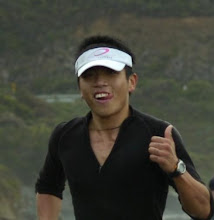Sunday, October 30, 2005
Night Watch
| Since 2001, no adventure racer in Singapore has been subject to the combination of sleeplessness and furious pace that is 1-day adventure racing. I aim to be the next one this 2005. Expedition length racers in Singapore have had to race in sleep-deprived conditions before, but they always have had the chance to sleep. Which leads to the question: Who owns the night? The recent Ace Adventure 3 was a testament as to how limited opportunities exist for our local athletes to be conditioned to race fast and smart under cover of darkness in off-road conditions. In a race lasting 24-36 hours, competitive teams will get by on zero sleep. The demands of such a race necessitate a pace that is faster than that of expedition-length efforts, sometimes as fast as sprint-level events. The night element, according to latest technological developments, is to have the best and brightest lights to last one night, especially for speedy / technical mountain bike legs - HID systems have come to the fore in this area. Expedition-length lighting, on the other hand, requires due consideration for weight savings, with little or no chance of recharging in unsupported conditions. It would be hell to lug heavy batteries, only to find out that the team can only move 'so fast' due to the sheer fatigue build-up over the days of the event. Therefore, for expedition-length lighting, only 2 HID systems at the most need to be on the team during MTB legs, with the other 2 team members having high-output LED systems. DUring movement, the point person dons the HID (backed-up with his own AAA headlamp); while the second person (navigator) has the less powerful LED (he may not even need to turn it on on flat sections); 3rd person is the weakest biker in the team, donning a HID; and the rear person should be the strongest biker, or the most competent in technical off-road, and able to conduct repairs - with an LED. During flat sections, HIDs will be turned off, and all will run on headlamps (as required per the trekking sections), as required by the presence of ambient lighting. During full-on technical sections, HIDs will be turned on in addition to the headlamps of the 2nd and 4th persons, with the point man and navigator (1st and 2nd persons) making sure to call out obstacles... LED systems will be turned on if the going gets really hairy for the 2nd and 4th, who should be competent enough to tackle the problem bits under LED lighting. During trekking legs, everyone can survive on headlamps running on AAAs. My best bet would be the PT EOS... a nifty 1Watt-LED product that is compact, reasonably lightweight, gives good throw for an LED, and has variable settings from 2.2 to 60 hours - oh and it's highly water-resistent too! I've found a way to wrap it around the handlebar of my bike, so that it becomes the back-up light (aka 'easy-terrain' light) during biking legs. I find it sad when not enough thought is put into lighting requirements. Night movement has been the inevitable Achilles Heel of Singaporeans... a combination of lighting that is too weak, lack of run-time (necessitating frequent battery changes.... ergh!), and not enough conditioning in realistic settings. The results: drastically slowed-down speed at night, navigation errors, accidents, and walking the trekking or biking sections that could have otherwise been run or ridden fast on, respectively. We don't have good enough lighting systems available in Singapore, for one thing; and we have not had the chance to prove on our own soil what works in race conditions - in an ACTUAL NIGHT RACE, off-road!!! That sucks. |
I will put an end to the ignorance - soon, we will be racing as fast as we do in the daytime, as other athletes of other nationalities do!

